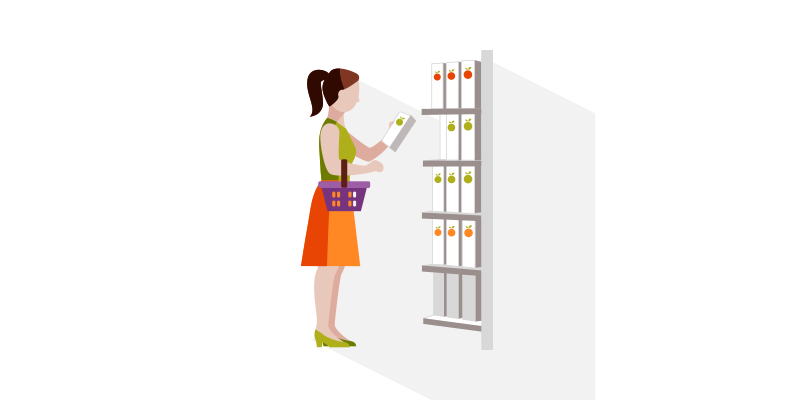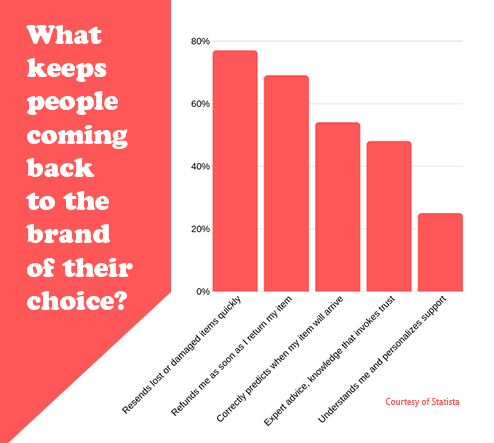-
New Customers vs. Return Customers: What’s the Difference?
Tue, 30 Apr 2019, in Customers
Liking this one? You might also enjoy 10 Employee Customer Service Skills & How to Identify Them

Imagine there are two companies with identical marketing strategies, adding new customers at a rate of 20 percent per year. However, one company retains 90 percent of their customers while the other 80. What this means is that the first company will have a 10 percent growth of their customer base every year, while the other will have none. If you stretch this over seven years, the first company will have doubled its customer base, while the second one will not have grown by much.
While a rise or fall in the number of acquired customers can be quite obvious (and have predictable immediate effects), a small change in customer retention can greatly affect long-term growth. As such, repeat customers are:
- Are already familiar with your product
- Eager to give feedback or share concerns
- Receptive to your marketing efforts
- Incredibly easy to convert or up-sell
- Tell their family and friends about you
The cost of new customers
Traditionally, the CAC (cost of acquisition) metric, which, along with the customer lifetime value (the value of the average customer’s lifespan), can offer companies a well balanced picture of the value each customer brings.
Cost of acquisition works hand in hand with the amount of sales that customer gets you over time. As a rough example, $10 to acquire a customer may be high if a customer only makes one purchase. But quite low if a customer makes a $25 purchase every month for 10 years.
The cost of repeat customers
In addition to the above, you need to understand what your customer retention rate is. That’s the percentage of customers who, over a period of time, repurchase when compared to the same period before.
Understanding what your cost per acquisition per each of your marketing type (or channel) could narrow down how many former customers you are targeting, too. That’s because a portion of the cost of gaining a new customer is used on a returning customer (you are re-engaging and converting your existing customers that already know and enjoy your product).
What keeps customers coming back?
What’s an easy way to get customers coming back? Just save them time.
In 2017, Statista discovered that customers required fast shipping and easy returns as a primary reason to stay – all things considered, saves customers tons of waiting. To a lesser degree, making a customer feel appreciated, valued and reinforcing their choice in sticking with you, all this makes them come back, too.

With virtually hundreds of options at our disposal at any given time (and with the paradox of choice fighting against us), we still prefer to stick to a few familiar brands that we choose to attach our loyalty to. This type of emotional connection is what every business fights for, and something that won’t easily be lost even if the competitor offers a lower price or a better product.
10 ways to increase customer retention
No matter how awesome you are, some customers will end up leaving, all thing considered. Few of us recognize this or spend time looking at these inactive customers – so instead of focusing all your time and energy on wooing over new blood, we’ve compiled a list of things you can do right now to reengage with your existing customers.

1. Improve communication
How do you talk to your customers? Do you reach them out of the blue? Is your message relevant to them? Take a look at your follow up strategy and ways you re-engage with customers. Pay attention to every communication channel, including:
- Emails. Whether you could have done something better, or to offer your availability, follow up often.
- Conference calls. Put a face to a name if needed. Keep barriers, commitment low and rewards high.
- In app notifications. After a specific milestone is accomplished, ask customers what they thought of it.

2. Request customer feedback
Often, a company’s perception doesn’t match with the customer’s reality. Short of contacting your customers with questions of importance to them, you’ll never know what they really want. Furthermore, over 95% of dissatisfied customers don’t complain or share feedback.
Tips: Create a system (such as help desk tags, public idea portal, etc) for uncovering complaints or ideas thrown your way. Engage with them and spend time on talking, hearing them out, and use it as an opportunity to get these customers to remain with you.

3. Forget about the program
Don’t think of your loyalty efforts as a “loyalty program”, think of it as a process that is applicable to all your customers. Think of it as a guideline instead, the bare minimum you should do to get your customers hooked onto your product or service.
Tips: This doesn’t have to be limited to price or features – instead, you’ll have to put more effort into your customer service, branding, unique thank you’s, activities surrounding special causes, freebies. Make sure your loyalty strategy is human and sincere.

4. Utilize customer tiers
No matter how similar you think your customers are, they’re all naturally different and may be using your product in a different way for different reasons. In this case, even basic customer segmentation is something that could definitely help out.
Tips: You may want to segment customers in order to offer specialized support or create a customer list for email offers. Think of what you have at your disposal. Name, address, birthday. On a customer’s birthday, why not make a priority of sending a happy birthday email?

5. Make use of points
Consider implementing a points system for customer rewards. This will help quantify customer value more precisely and allow you to visualize how much profit a customer is bringing you. This will get you in control of customer relationships, not to mention marketing and other expenditures.
Tips: Establish a “star” system for each dollar spent and coordinate the number of points you need to receive a specified discount on the next purchase. Consider a freebie or a specific white-glove treatment you could offer to those customers.

6. Support their cause
Some people, particularly in the US are likely to buy from (or boycott) brands based on their corporate adherence to social causes. This means that social welfare, economic development and even controversial, divisive issues are top issues for cultivating loyalty.
Tips: Run a survey, find out what customers “expect” out of a company. What do they consider a responsible company? Could it mean being a good employer? Operating in a socially/environmentally beneficial way? Investing in social justice causes?

7. Show appreciation
Aside from your product or customer service, the easiest way to get customers to stick around is to simply let them know they matter. Remember that actions speak louder than words, and sometimes, a surprise card, free sample or gift certificate can make anyone’s day.
Tips: There are many ways to express thanks. Send a surprise card for a new customer, free gift with a purchase or a post-purchase discount. However, don’t get your appreciation efforts to replace great customer service, have it complement your support.

8. A contest, draw or sweepstakes
If you’re building loyalty on a small budget, run a simple contest or do a prize draw. This way you can reach a large number of your customer base, without spending much money in the way of prizes. Combine it with a short survey to gather feedback.
Tips: Create a number of contests for your most engaged, or most important customers. Make it a regular event, as it will maintain intrigue and build engagement – it’s a great excuse for sending that email newsletter or a way to follow up with those silent customers.

9. Partner up with a business
When companies join forces, their customers are taking notice. Brand image and values usually change once you partner up with a higher-value brand. Changes in operations, product prices or marketing costs can also help get a more loyal customer following.
Tips: Sometimes a strategic partnership is the fastest way to increase customer retention, but only if your partner has a loyal customer base and a reputation for excellent customer service. Partnering up with a poorer value brand however, could have the opposite effect.

10. Build a fan community
Over nine out of ten customers don’t expect perfection from businesses – as long as a business is honest about their efforts. It’s not surprising that honesty and transparency is a key factor driving customer loyalty. Make your customers feel like they belong with you, like they can trust you.
Tips: Create a community that embraces criticism and dialogue, and engage with positive and negative comments alike. Engage with all customers equally, and extend a helping hand or lend an ear to everyone who’s raising concerns.
In conclusion…
Most businesses spend a large bulk of their time in building the initial customer relationship, building up the brand, the product, and eventually the sale. However, what happens after the sale? In some cases, the interest in continuing that relationship tapers off, (worse still, it happens when the customer runs into a problem).
Customers will take notice if you are open and honest with them, take initiative to care and be interested in them. If not, they’ll find excuses to avoid you at the next chance they get.
Read More: 20 Customer Service Management Tips to Implement Now